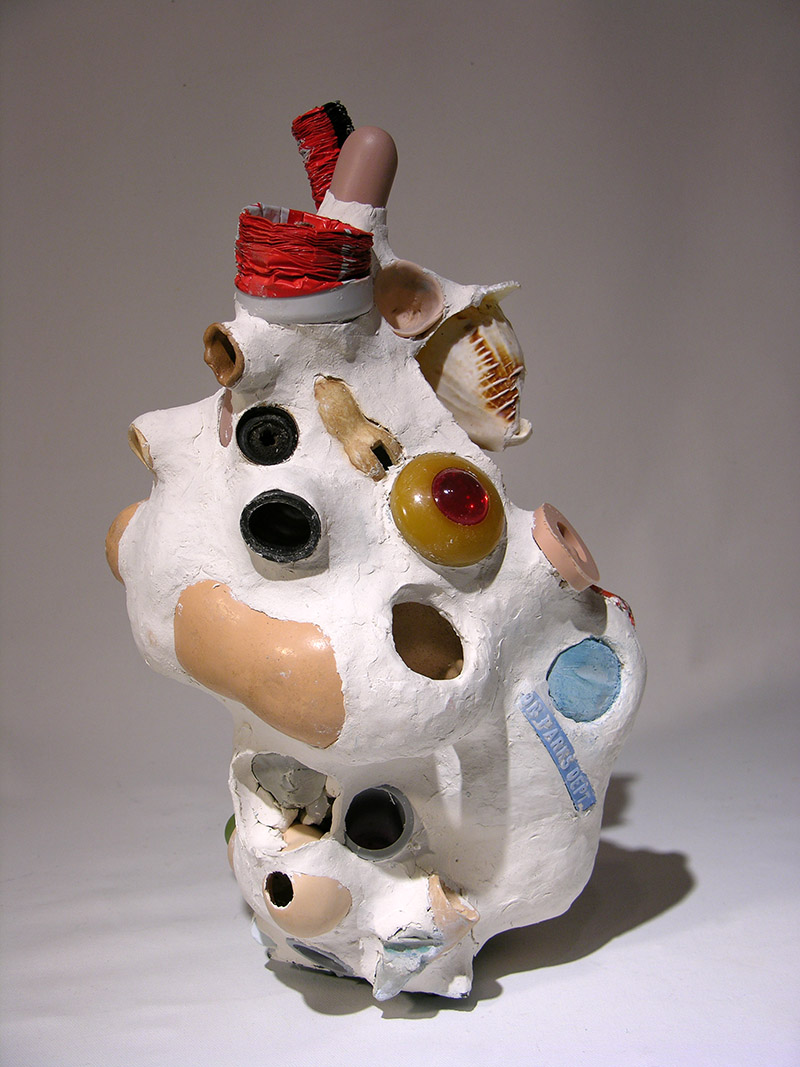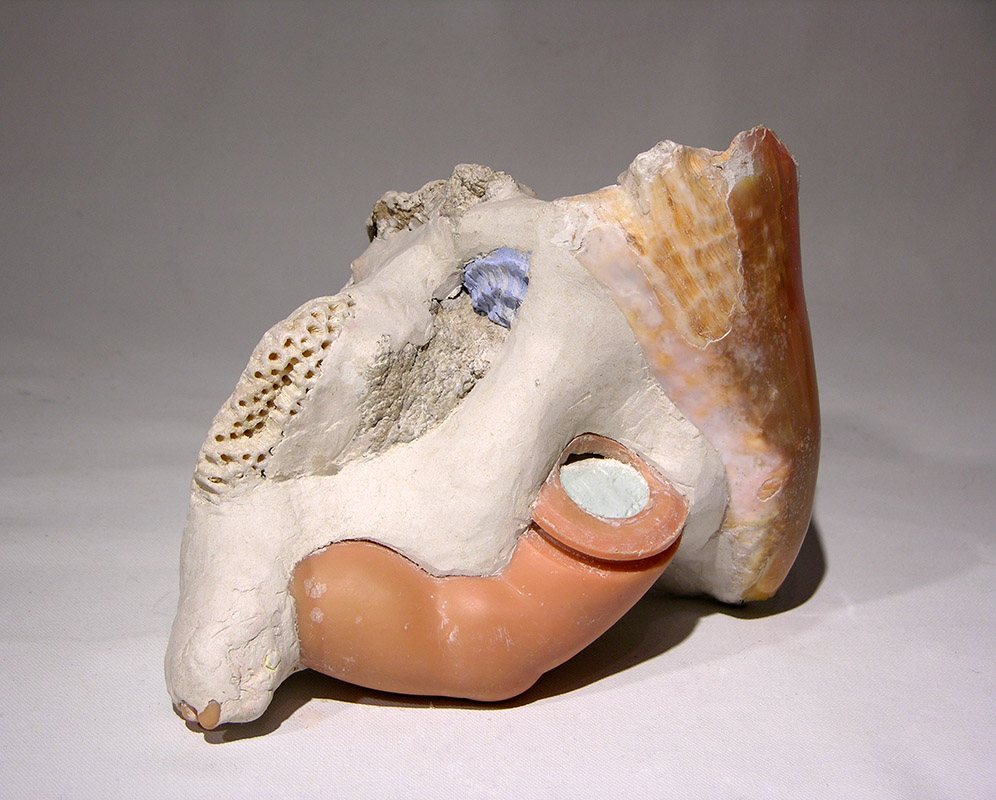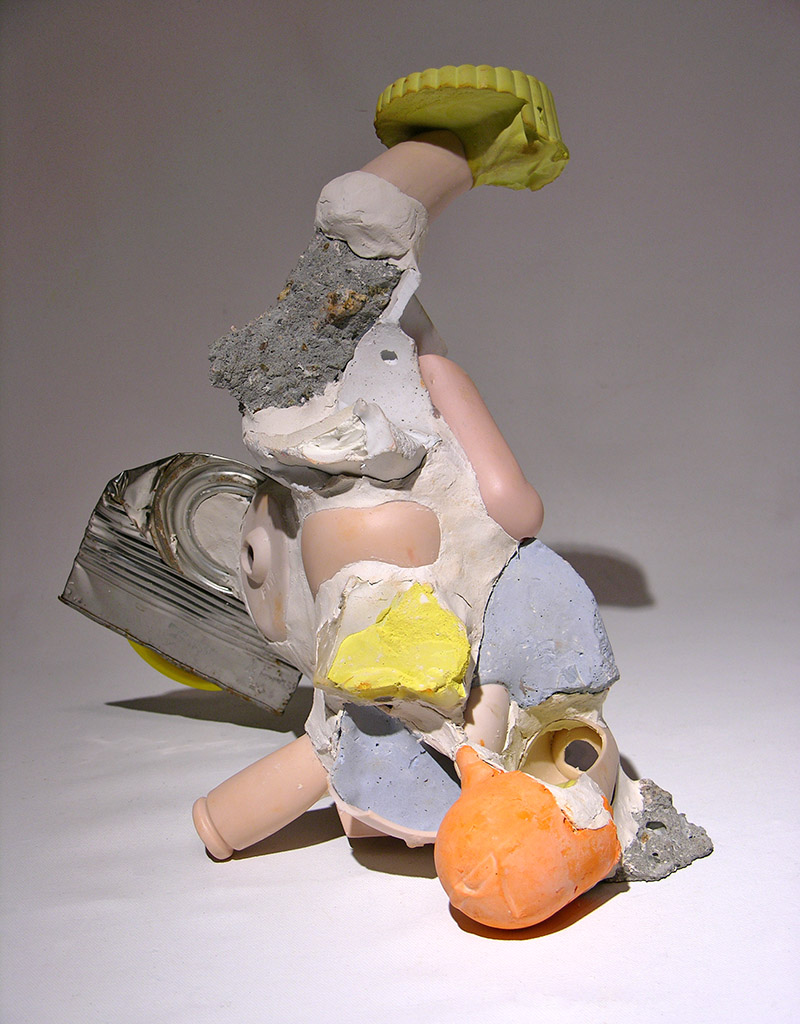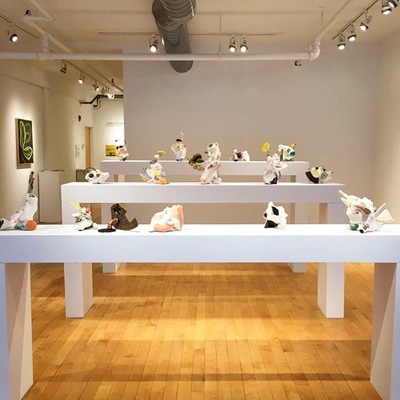Linda Leslie Brown
RECENT WORK PAST WORK INSTALLATION | ABOUT RESUME PRESS | CONTACT ![]()
Of the Dense and Porous: More Holes by Linda Leslie Brown
by Heather Davis
 “The brilliance of Brown’s artistic rendering is in provoking reflection on the meaning of all these objects, all this waste, while still providing holes. The porousness of the work suggests a future already in the process of being reworked. The holes refute ideas of masterful progression, instead creating a sense of the unfinished, while at the same time providing more surface and more entryways into the work. The sculptures look as if animals have already made a home in them, moving through the dense layers of plastic and metal and ceramic. Things that used to have a definitive form, that once had commercial value, appear instead to have become the dwellings of burrowing creatures and waste-consuming bacteria.” (Excerpt)
“The brilliance of Brown’s artistic rendering is in provoking reflection on the meaning of all these objects, all this waste, while still providing holes. The porousness of the work suggests a future already in the process of being reworked. The holes refute ideas of masterful progression, instead creating a sense of the unfinished, while at the same time providing more surface and more entryways into the work. The sculptures look as if animals have already made a home in them, moving through the dense layers of plastic and metal and ceramic. Things that used to have a definitive form, that once had commercial value, appear instead to have become the dwellings of burrowing creatures and waste-consuming bacteria.” (Excerpt)
by Shana Dumont Garr
 More Holes, a new series of sculptures by Linda Leslie Brown, possesses a wild elegance, with symmetry angling towards complexity at every turn. The sculptures integrate varied forms, cohering them into a new object but also referring to assemblage, as we may parse their origins. Bright, smooth found objects such as doll limbs, light bulbs, and plastic fragments interrupt the neutral tones of plaster and shell binding each piece, resulting in forms of rugged textures and intricate compositions.
More Holes, a new series of sculptures by Linda Leslie Brown, possesses a wild elegance, with symmetry angling towards complexity at every turn. The sculptures integrate varied forms, cohering them into a new object but also referring to assemblage, as we may parse their origins. Bright, smooth found objects such as doll limbs, light bulbs, and plastic fragments interrupt the neutral tones of plaster and shell binding each piece, resulting in forms of rugged textures and intricate compositions.
Despite their small size, it is impossible to summarize each work from a single point of view. Like unearthed, archaeological treasures, a key part of the sculptures’ strengths lie in their inscrutability. They present as collaborations with nature, with materials transformed by time, tides, or burial, or mutant growths after a radioactive disaster. Yet unlike fossils or artifacts, the sculptures integrate objects that are familiar and contemporary to our time. The humble, funky, at times awkward silhouettes encompass a range of contradictions — organic and manufactured, bright and muted, sharp and smooth, foreign and familiar— embracing binaries in a way that embodies wisdom and pathos.
The variations they encompass push us to understand how they may cohere. At the scale of our hands, or head, they represent ideas, or symbols of things. If we imagine them as scale models that could potentially be built to full size, they’d conjure the fantastical and bright architecture of Antoni Gaudi. However, Brown’s series maintains a consistent, hand-made scale, conversing with aspects of Kathy Butterly’s ceramic vases which also maintain a small scale, possess pink flesh tones that reference the body, and dazzle the eye with gem-like pops of color.
You could hold each of Brown’s sculptures with two hands, like tactile oracles, or a magic eight ball. Pick one up, gently shake it, then peer down into a small, reflective cavity and see if you can tell the future: outlook good? Very doubtful?
The integration of artificial and real, secret and exposed, emerge as central themes, referring to rapid changes in our world such as the amount of plastic in our oceans, or how thoughts seem to partly dwell in one’s hand in the form of a smart phone. In a sense, the sculptures awaken us to the fact that the future is now: that we and our environment are forged in part with artificial materials. The sculptures comment on the current state of our environment, on the vital force of human connection, and on the potency of materiality in advancing emotional expression.
As emblems of decay, the works imbue a sense of doom tempered by humor, with organic forms and plastic detritus appearing in equal measure. The exhibition title, More Holes, refers to the porous, eroded forms of the art; as Brown says, “these works are half created and half destroyed.” We see sea glass, a neon gum dispenser, and the plump, round bottom of a baby doll. They ask us to peer into voids, and to accept some uneasy tensions between naturally occurring and manufactured objects, between personal and public space. The works also directly refer to parts of the body, bringing up vulnerability and psychology as Louise Bourgeois did with her humble, wounded, yet grand sculptures.
Brown was influenced by working in the Bahamas in 2015, and indeed, parts of these sculptures, including shells, were found during her time there. As an artist-in-residence, she realized how accentuated the extreme poverty and income disparities between tourists and residents were in that setting. We may associate her sculptures made in the course of the next year with the act of collecting and of actively creating relationships between things and, by extension, the people who use them. Even in the midst of chaos, rubble, and rapid change, we may find the possibility for healing and growth. It is decidedly so.
by Alexander Castro, Big Red & Shiny, May 25, 2016

“As a reflection on “porosity and vulnerability,” Brown’s sculptures recall the words of theorists Annemarie Mol and John Law: “The body…is not a bounded whole: its boundaries leak. Bits and pieces of the outside get incorporated within the active body.”
Permeability and potentiality are frequently summoed in Brown’s studio, where objects are apt to lose all stability through a Kali-esque process involving both destruction and creation. Junk must be fragmented nbefore it can be subsumed into a new, fractured whole. Brown works on the pieces from “all sides, including the bottom,” producing uneven, diversely textured work like Mother or Rushin’. “It’s important to me that they continuously change as you move around them,” Brown says. To borrow a line from Ovid, her “intention is to tell of bodies changed.” Read the full article >
by Olivia J. Kiers, Art New England Online, May 11, 2016
 “As soon as you enter the Kingston Gallery, Linda Leslie Brown’s recent, whimsical mixed-media sculptures not only catch your eye, they seem to return your gaze. Ranged on a series of high benches that rise like bleachers from the middle of the gallery floor, Linda Leslie Brown: More Holes is an exhibition that confounds expectations. Part of the viewing experience is shaped by the unusual arrangement of the show. By eschewing the plinth as a support, More Holes organizes rather than presents its objects in a manner that is more evocative of the tiered vitrines of a natural history museum than a gallery show. Yet, these are unclassifiable objects, and organizational systems seem pointless when confronted with their mutable nature. Indeed, this is one exhibition that raises more questions than it answers, and that is the genius behind Brown’s sculpture.”Read the full article >
“As soon as you enter the Kingston Gallery, Linda Leslie Brown’s recent, whimsical mixed-media sculptures not only catch your eye, they seem to return your gaze. Ranged on a series of high benches that rise like bleachers from the middle of the gallery floor, Linda Leslie Brown: More Holes is an exhibition that confounds expectations. Part of the viewing experience is shaped by the unusual arrangement of the show. By eschewing the plinth as a support, More Holes organizes rather than presents its objects in a manner that is more evocative of the tiered vitrines of a natural history museum than a gallery show. Yet, these are unclassifiable objects, and organizational systems seem pointless when confronted with their mutable nature. Indeed, this is one exhibition that raises more questions than it answers, and that is the genius behind Brown’s sculpture.”Read the full article >
[photo credit: Ann Wessmann]